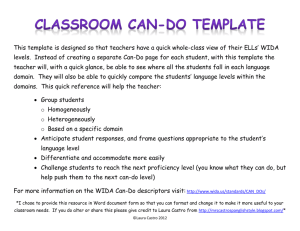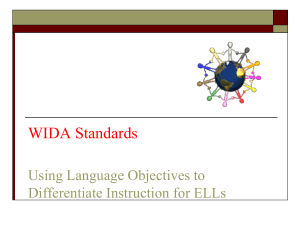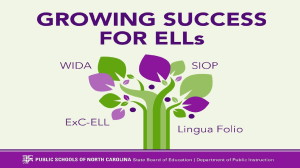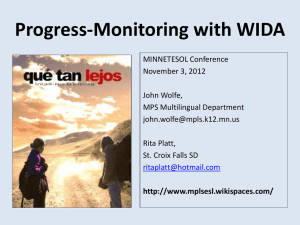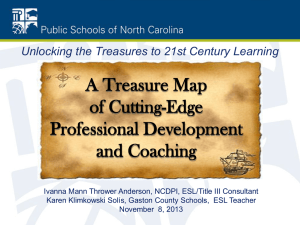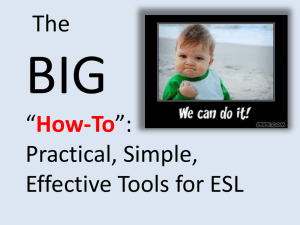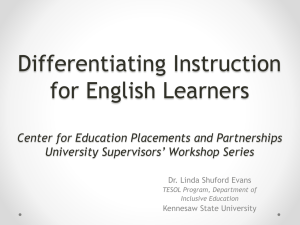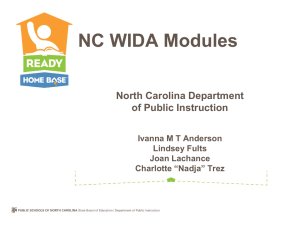WIDA_Works_Session3 - 3 C`s ESL Tools and Strategies
advertisement
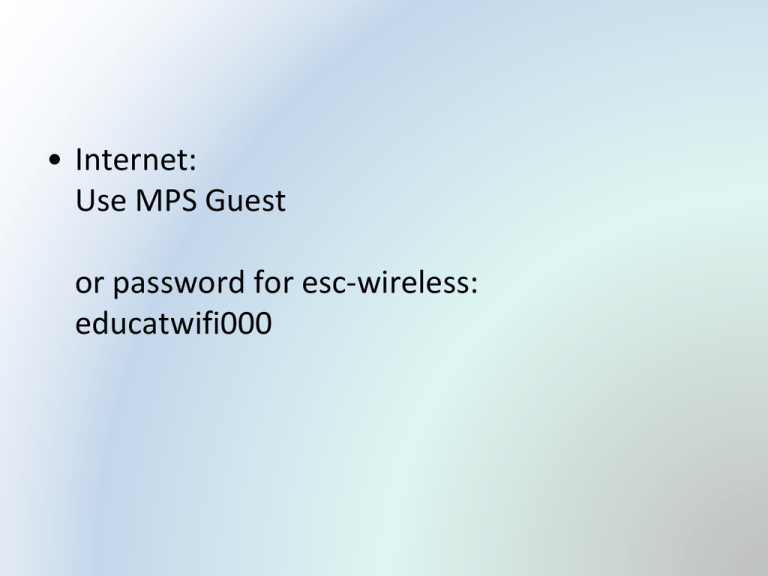
• Internet: Use MPS Guest or password for esc-wireless: educatwifi000 Making WIDA Work for You! Relax … Everything (and more) is on The Wiki http://www.mplsesl.wikispaces.com/ Questions to be Answered HOW DO WE USE THE WIDA TOOLS? • • • • What are the WIDA Proficiency Levels? What are the WIDA Standards? How do the MPIs work? How do the Can-Do Descriptors relate to the MPIs/Standards? How do the Student-Friendly Descriptors fit in? • How can we use WIDA to differentiate instruction? • How can we use WIDA tools to monitor progress? Why Are These Questions Important? 1. We have adopted the WIDA model. 2. WIDA is a top-of-the-line instructional tool. 3. Tools are best used when they are VERY familiar. 4. The more complex the tool, the higher the cost of entry… 5. The gift of time… WIDA: The Bigger Nutshell 1. Language is the tool for learning! 2. LEP’s are in mainstream classrooms. (95% of the time in MPS.) 3. LEP’s use their Limited English to learn in 5 basic contexts (Language Arts, Science, Social Studies, Math, Social & Amplification.) 4. Language no matter how limited is an asset to learning. You work with what you’ve got! 5. WIDA helps all teachers modify the language demands of instruction to provide LEP students with meaningful access to content. Up the Triangle = A More Specific View but … we now have enough to work with…. Student Friendly Can-Do’s Performance Defs informed by the What students can do with language BROADLY CVC Criteria But what does that look like at different grades? With different language domains? (Speak/Listen/ Read/Write) Two Key Roles of the ESL Teacher English Language Development Meaningful Access to Grade-Level Learning Informed by Informed by Second Language Acquisition Theory WIDA Standards & Tools • a communicative focus, • commitment to Academic language • intensified practice of academic speaking and listening • opportunities to focus on FORM (i.e., grammar, correctness of language) • systematic attention to developmentally appropriate vocabulary & grammatical structures differentiate instruction based on student language proficiency, match the language demands of content instruction to the student’s language abilities, (and, ultimately) provide learners with supported opportunities to expand proficiency through challenging language tasks (speaking, listening, reading and writing) above their current levels (i+1 or ZPD) In the service of both goals: Ongoing Progress monitoring of English Language Development Data-Based Decision Making 1. Assess 2. Analyze results 3. Set goals for student growthplan interventions to meet goals 4. Teach for growth toward goals 5. Reassess 6. Tweak plans 3 ½ Steps to Differentiation with WIDA Repeat Repeat Repeat Continuous Improvement Model WIDA—Putting it All Together Illustrate what students can do at each level in context (in the Remember language serves content learning content area) What students can do with language broken down by domain What students can do with language BROADLY (Speaking, listening, reading, writing) Today’s goals: USE THE 3 ½ STEPS TO DIFFERENTIATE USING THE WIDA LENS 1. Reformat activities or aspects or steps of a lesson-sequence into MPI format 2. Determine the WIDA level 3. Design an analogous learning activity appropriate for lower levels 3 ½ . Consider levels of support/scaffolding that might be needed Model Performance Indicators (MPIs) 2007 The MPIs Consist of Two or Three* Elements: • The language function describes how students use language - the intent of the communication • The content stem specifies the context or topic that is addressed - a curricular kernel • The strategy or support * Supports In a Nutshell • An MPI tells us what we’re doing…they force us to clarify: Do NOT try to make a – The language function: What type of language differentiated MPIoffor each performance will be demanded students – The content: The actual content subject matter part of a lesson sequence you are teachings – The supports: What supports are in place and/or or even each objective! what supports need to be in place Steps towards WIDA Transformations Analyzing a Model Lesson from a WIDA Perspective: Sequencing in Number the Stars • Decide on the following: – – – – – Language domains? Language function? Content topic? Type of support ? Which Can-Do levels are being served? Characteristics for Performance Definitions 1 2 3 4 5 6 ENTERING EMERGING DEVELOPINGEXPANDING BRIDGING Linguistic Complexity: The amount and quality of speech or writing for a given situation Vocabulary Usage: The specificity of words or phrases for a given context Language Control: The comprehensibility of the communication based on the amount and type of errors R E A C H I N G Steps towards WIDA Transformations Analyzing a Model Lesson from a WIDA Perspective: Sequencing in Number the Stars • Decide on the following: – – – – – Language domains? Language function? Content topic? Type of support ? Which levels are being served? Try It! 1. Watch the video. 2. Structure the activity as an MPI. • What is the language function, the content, the support? • What level is it best suited for? How do you know? • Use the Can-Do Descriptors to help you decide: – What support or modifications will your students need to have some level of meaningful participation? Your Time! • Think about lessons you teach • Think about the sequence of activities that make up the lesson • Transform each activity into an MPI structure • Consider the WIDA level the lesson is appropriate for • How can you modify the lesson to meet multiple levels (or at least level 3) Two Key Roles of the ESL Teacher English Language Development Meaningful Access to Grade-Level Learning Informed by Informed by Second Language Acquisition Theory WIDA Standards & Tools • a communicative focus, • commitment to Academic language • intensified practice of academic speaking and listening • opportunities to focus on FORM (i.e., grammar, correctness of language) • systematic attention to developmentally appropriate vocabulary & grammatical structures differentiate instruction based on student language proficiency, match the language demands of content instruction to the student’s language abilities, (and, ultimately) provide learners with supported opportunities to expand proficiency through challenging language tasks (speaking, listening, reading and writing) above their current levels (i+1 or ZPD) In the service of both goals: Ongoing Progress monitoring of English Language Development Basically … • The WIDA Tools are designed to indicate what students should be able to do in the service of grade-level learning at their proficiency level • But we recommend also using them tool to bridge from one level to the next (as a tool for ELD) • Can-Do Descriptors (combined with the CVC Criteria) can be the heart of progress-monitoring. Why? • Because the Can-Do Descriptors are essentially a Developmental Progression Learning progression • Natural Order Hypothesis (Krashen) But … you may want to use WIDA as your main monitoring tool and Dutro’s Matrix as the supplement .. “Student-Friendly” WIDA CAN DO Descriptors: Grade Level Cluster 3-5 For the given level of English language proficiency and with visual, graphic, or interactive support through Level 4, English language learners can process or produce the language needed to: Level 2: Beginning Level 3: Developing Level 5: Bridging Listen to information and apply to a new situation. Listen to follow instructions about [math or microscopes or whatever] Listen and point to pictures or words Listen to descriptions and sort pictures. Follow one-step directions Listen and arrange pictures. Listen to an explanation and match it to a picture. Listen and find things or people Follow two-step directions. Match descriptions to illustrations. Listen to the teacher and do the classroom routines. Listen and draw pictures. Listen to a story and sort pictures. [Listen to an explanation and …] Listen to [a story, an explanation] Answer [simple] questions about [school subjects] Give reasons for an opinion. Use evidence to defend opinions. Understand and begin to produce the following verbs for observable actions and descriptions: Discuss stories, issues and concepts. Give oral presentations using technical vocabulary. Present tense • be • have • like • need • want Listen to choices and express an opinion. Tell what you need. | Tell how you feel. Ask everyday questions. Say the names of things. Restate facts about school topics. Repeat words and phrases from pictures. Describe [people, events, objects, or people]. Answer yes/no questions. Answer choice questions. Talk about yourself with other students. Follow directions. Level 4: Expanding Re-tell stories. [Re-tell events.] Listen to [stories, explanations] and make predictions. Listen to [stories, explanations] and guess why things happened. Listen to an explanation and point out details on an illustration. Listen about authors [scientists, etc.] and act out what you hear. Give oral reports. Compare solutions to a problem. Compare and contrast [ideas from a subject]. [Using a model], listen to a problem and use models to figure it out. Listen and explain figurative language. Listen to [stories, explanations] and give opinions. List the steps you take to solve a problem. Explain the results of an experiment. Offer solutions to social conflicts. Susana Dutro’s ELD Matrix of Grammatical Forms Beginning DESCRIBING ACTIONS & STATES OF BEING: VERBS Speaking Listening Level 1: Entering Respond to routine can and do questions with an action or orally (yes/no, single word) Can I help you? Do you need a ___? Can a bird fly? Does a square have three sides? Present progressive statements Ex: walking, Is reading, She is running. Imperative (receptive) Ex: point to, pick up, stand up Auxiliary Uses can in simple statements with concrete verbs: She can read. Birds can fly. Make presentations. Follow written directions. (visually supported) Writing Write the words that tell about things Tell what I think by drawing Copy words and short sentences Answer questions with one word Make lists from labels or with other students Finish or write sentences using word walls Fill in graphic organizers, charts, and tables Write a comparison about [some realia] Sequence events in stories [articles, explanations, historical accounts]. Find details that support main ideas. Use context clues and illustrations to figure out the meaning of words or phrases. Write stories or reports Write sentences that go together Write what is the same and different about two sets of information Distinguish fact and opinion. Identify and explain examples of figures of speech. [Give examples of figures of speech.] Make inferences. Use graphic organizer to take notes Write responses to texts near my grade level Summarize information about a subject Write about [new situation] using information I learned in class Write different kinds of texts Write about things or people or ways to do something Answer thought questions. Tell how I solved a problem Make text-to-self connections Write stories or reports Wolfe Platt | http://mplsesl.wikispaces.com/WIDA+Tools NAMING PEOPLE, PLACES, THINGS: NOUNS & ARTICLES PRONOUNS Choose the graphic organizer that matches a text. Places & Things: Identify elements of stories [characters, setting, etc.] Identify main ideas and some details. Summarize information from [#] sources. RE-Naming People, Match words on the board to words and pictures. Classify features of genres. Common singular and plural nouns and articles Note: use with appropriate article as a pair (i.e. the book, an orange) CONNECTING IDEAS: PREPOSITIONS Find changes to root words in sentences or stories. Interpret data from charts and graphs. Level 5: Bridging Present tense Including: be, do, have, need, see, know run, draw, make (I like my dog, She likes cats. He is a boy. I have two sisters.) Present progressive statements & questions Ex: play, read, work, eat, drink (She is laughing. Is she reading?) Past progressive statements & questions was, were (Ex: was walking, were walking) Intermediate Learn to understand and produce regular & irregular past tense verbs in: ! Positive/negative statements Ex: lived, walked, went, did not live, did not go (He talked on the phone. She saw her friend yesterday.) ! Positive/negative question Ex: were/weren’t, did/didn’t, could/couldn’t, was/wasn’t Negative present and past progressive Ex: was/were not, were not walking Contractions Ex: I'm, she’s, I’ll, we’ll, can't, wasn’t, weren’t, isn’t Present perfect tense with routine statements and questions have/ has + past participle: (She has been in my group since November.) Statements and questions with there is and there are Future tense statements and questions going to, will Imperatives such as: Please be quiet. Play soccer with me. Bring your book. Auxiliary do, and can in routine questions and statements. (Do you have/need a pencil? How do you spell your name? Can you see the board? Yes, I can. Can you help me? I can help you. May I go to the bathroom? Formulating Questions (past, present, future) with who, what, where, when, how many, how much, why (How much is it?) Formulating above questions with do and does (How much does it cost?) Statements and questions with there was and there were Imperatives such as: Stop doing that, please. Let’s play soccer now. Auxiliary verbs may, might, must, should, could, would (You should study. I might be late. We could divide by 5. Would you…?) Exclamations such as: What a great idea! That’s not fair. Simple idioms such as: Give me a break. It's raining cats and dogs. Location on, off, in, out Direction up, down Present & past perfect have/has/had + past participle Positive/negative statements: I have studied ballet since I was six. Kennedy hadn't been president long. Questions How long have you___? Phrasal verbs Turn on the light. Turn the light on. Clear your desks off. Clear off your desks. Advanced Learn to understand and produce verb tenses appropriate to the situation: Progressive, future and conditional perfect tenses She has been studying. She will have been studying, If she had studied, she would have done better. Common singular and plural nouns and articles Note: use with appropriate article as a pair (Ex: a pencil, an oval, the ball) Articles for specific & general nouns (Ex: the best song, a good song; the answer, an answer) Collective nouns Ex: team, group Possessive nouns Ex: teacher's, friend's Uncountable nouns Ex: some water, a lot of chocolate, a little glitter Collective nouns Ex: flock, box of ____, bunch of kids, flowers, Irregular plurals Ex: fish, teeth, mice Object pronouns me, you, her, him, it, us, them Demonstrative pronouns this, that, these, those (Ex: Those are his. These are mine.) Possessive pronouns her, his, our, their (Our ball, her book, their team) Demonstrative pronouns used in routine statements and questions Ex: Is this ___? This is ____. Possessive pronouns my/mine, your/ yours, her/hers, his, our/ours, their/ theirs. It’s my lunch. It’s mine. Location such as: inside, outside, at, next to, beside, between, behind, above, below, under Location such as: on the left/right, in the middle of, underneath, in front of, in back of, near Direction such as: over, under, through, across, around, into Time such as: before, after Statements and questions with there will be/there has been Phrasal verbs with multiple meanings (often idiomatic) Ex: make up (your mind, a story, the class, your face, with a friend). Conditional statements and questions using if and auxiliary verbs would, will, may, might, must, can could, should (If we see a brown bear, we will not feed him. We can make it to the show if we leave now. If we left now, we would be on time. If you don’t…) Synonyms Ex: responded/cried; stroll/ hike/march Exclamations such as: You have got to be kidding! That’s unbelievable! Passive voice It was written by..., This picture of a grizzly bear was taken by my grandfather. Conditional statements using unless: Unless I turn in my essay, I won’t be able to go to recess. Auxiliary: ought, will/shall (We ought to check in the book.) Prefer to/would rather Exclamation such as: That’s beyond belief! Less obvious idioms such as: Hit the ceiling, scared silly, lend me a hand Derivational Ex: sad, sadness Possessive pronouns my, your Early Advanced Learn to understand and produce verb tenses appropriate to the situation: Susana Dutro’s ELD Matrix of Grammatical Forms Routine statements & questions using who, what, where, when and how. (What is your name? What can a dog do? A dog can bark. How old are you? How are you? Where is ___? I like baseball. She is my sister.) Difficult plurals Ex: boxes, roses, faces Subject pronouns I, you, he, she, it, we, they Questions with whose and which (Whose shoes are these? They’re his.) Direction such as: to, from, toward, into, out of, through, by, past, to the left/right Time such as: at [certain time], on [certain day of the week], in [certain month, season], after, before Content area abstract nouns Ex: democracy, safety, freedom Figurative language using metaphors, similes such as: Love is a rose. She runs like a cheetah. Derivational Ex: converse, conversation Derivational verb to noun gerunds Walking is healthy. Feeding bears is not a good idea. Reflexive pronouns (myself, yourself, himself, herself, ourselves, yourselves, themselves) Reciprocal pronouns each other, one another) Indefinite pronouns (some/any/no/every + body/one/THING/where) Verb-preposition combinations, such as: belong to, wait for Specialized prepositions Until, since, for, against, onto Relative pronouns used to introduce an adjective clause with who, whom, whose, which, that Verb-preposition combinations, such as: agree with, answer to, separate from Time such as: during, while, from, to Teach prepositions as they occur with new verbs, adjectives: turn off/on, look at/for/up, care for, differ from/with To combine pen and pencil, brother and sister, running and skating CONNECTING IDEAS: CONJUNCTIONS Make sound/symbol/word relations Level 4: Expanding To combine using and & both (Bats and owls both fly.) To contrast using or (You can use a pen or a pencil. Adjective placement Ex: big cat, red ball Ordinal numbers Ex: first, third (1st through 10th) Concrete, descriptive adjectives for number, color, size, sensory, to describe how it feels and sounds Descriptive: big, brown ADJECTIVES Identify cognates. Read texts with illustrations and identify facts and ideas. Level 3: Developing DESCRIBING WHAT KIND, HOW MANY, HOW MUCH, WHICH ONE: Reading Match symbols to words [or concepts] Level 2: Beginning DESCRIBING WHEN, WHERE, HOW, WHY: ADVERBS Solve problems. Level 1: Entering Early Intermediate Learn to understand and produce for observable actions and descriptions: To explain: because (I like soccer because it is fun.) To contrast: but (I like apples, but not bananas. Owls are birds, but bats are mammals.) To show cause/effect: Ex: so, because (We are selling candy so we can take a trip. The ship sank because it had a hole) Quantities Ex: few, a lot, many Comparative & superlative adjectives with special forms, such as: good, better, best; bad, worse, worst; some, more, most; little, less, least Comparatives -er, (faster, bigger) Comparatives with –er than and as___as (Taller than, as tall as) Superlatives -est, (biggest) Multiple adjectives (dry brown soil) Demonstrative adjectives this, that, these, those (Ex: This book is about a whale. That one is about a horse.) Antonyms Ex; tall/short, slow/fast, new/old Derivation: noun to adj. (care, careful) Synonyms and antonyms such as: nice, likeable, mean, evil Dutro’s ELD Matrix of Grammatical Forms Adverbs with -ly in routine expressions Ex: slowly, loudly (Walk slowly/quickly to the door. Say your name quietly/loudly.) Adverbs with -ly We walked slowly Adverbs of time Ex: yesterday, today, tomorrow Extend speech for specificity (Yesterday we walked slowly through the park.) Formula phrases with very (very big, very good, very quiet) Modify adjective (I was very late. The problem was too hard.) Adverbs without -ly Ex: well, very, too, enough To describe frequency Ex: always, never, sometimes Common verb + too (Can I come, too?) To explain: not only/but also, although To contrast: however, either/or; neither/nor; yet To show cause/effect: therefore Quantities Ex: any, much, several, each Too + adjective (too red) Similes (as red as a rose) Adjectives with -ish or -y (milky, sluggish) Synonyms and antonyms such as: pleasant, agreeable, delightful, vile, despicable, enormous, gigantic Too + adverb (too fast, too carefully, too loudly) Well vs. good (Good job; well done; that was a good book; she writes well) To describe frequency such as usually, rarely, seldom, frequently, often Such as, whenever, as soon as, whether/or and whereas used to form adverb clauses which show time and cause and effect relationships. Abstract idiomatic expressions Abstract similes and metaphors from literature (Ex: as cool as a cucumber) Adjective clauses introduced by relative pronouns (He was the teacher who taught history.) Adverb clauses introduced by subordinating conjunctions (Clap twice whenever you hear the sound.) Specialized adverbs such as already, yet, still, anymore May 2; #4.3; “What is theme?” Plus … a Class ELD Progress Monitoring Form Period ______ ELD Monitoring Sheet | Speaking (Grs 3-5) ESL Tchr Gr Co-Tchr / Subject Period Week(s) # Question: 1 2 How often would you do a focused speaking progress assessment like this? Especially considering that you might also be monitoring progress in the other three domains? 3 4 5 6 7 8 9 10 Number of EL’s at WIDA Lvl 1 2 3 4 5 Topic | State Curriculum Standard Last, First WIDA Lvl Can-Do # | Goals & Notes C V C Data-Based Decision Making 1. Assess 2. Analyze results 3. Set goals for student growthplan interventions to meet goals 4. Teach for growth toward goals 5. Reassess 6. Tweak plans Repeat Repeat Repeat Continuous Improvement Model Involving Students in Learning Students must be INVOLVED to be motivated! Purpose Mastery Ownership (Autonomy) THINK PINK!!! Leads to M O T I V A T I O N Leads to… ACHIEVEMENT! Name: ____________________________ Date: ________ _______________’s Goal Sheet _____________________ Level: _____ _______________ by I can work on 1. Looking at the _________________ example 2. _____________________ Level: _____ _______________ by I can work on 1. Looking at the _________________ example 2. Name: ____________________________ Date: ________ _______________’s Goal Sheet _____________________ Level: _____ _______________ by I can work on 1. Looking at the _________________ example 2. _____________________ Level: _____ _______________ by I can work on 1. Looking at the _________________ example Questions to be Answered HOW DO WE USE THE WIDA TOOLS? • • • • What are the WIDA Proficiency Levels? What are the WIDA Standards? How do the MPIs work? How do the Can-Do Descriptors relate to the MPIs/Standards? How do the Student-Friendly Descriptors fit in? • How can we use WIDA to differentiate instruction? • How can we use WIDA tools to monitor progress? Ready, FIRE, Aim!!! Remember…. • Be kind to yourself! • It won’t all happen at once. • It won’t all go right. • You CAN get there….but it’s a JOURNEY. • It is a journey we MUST take.
